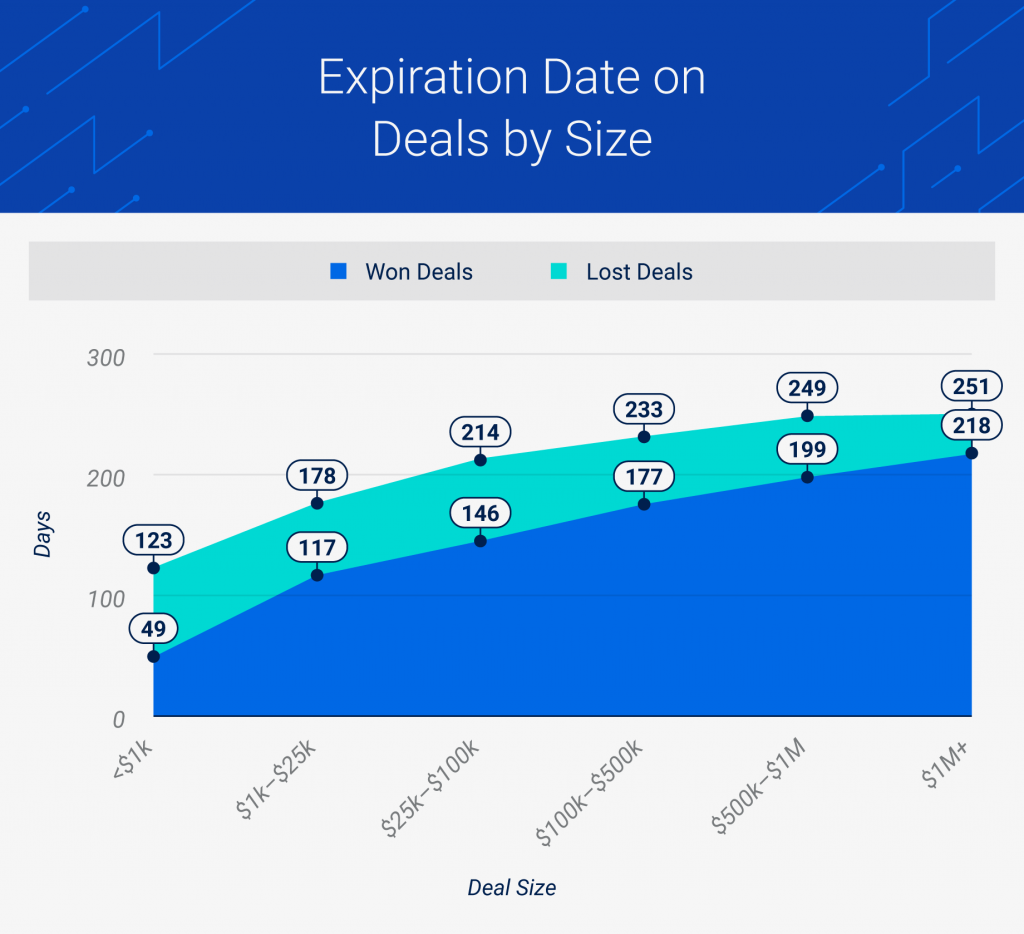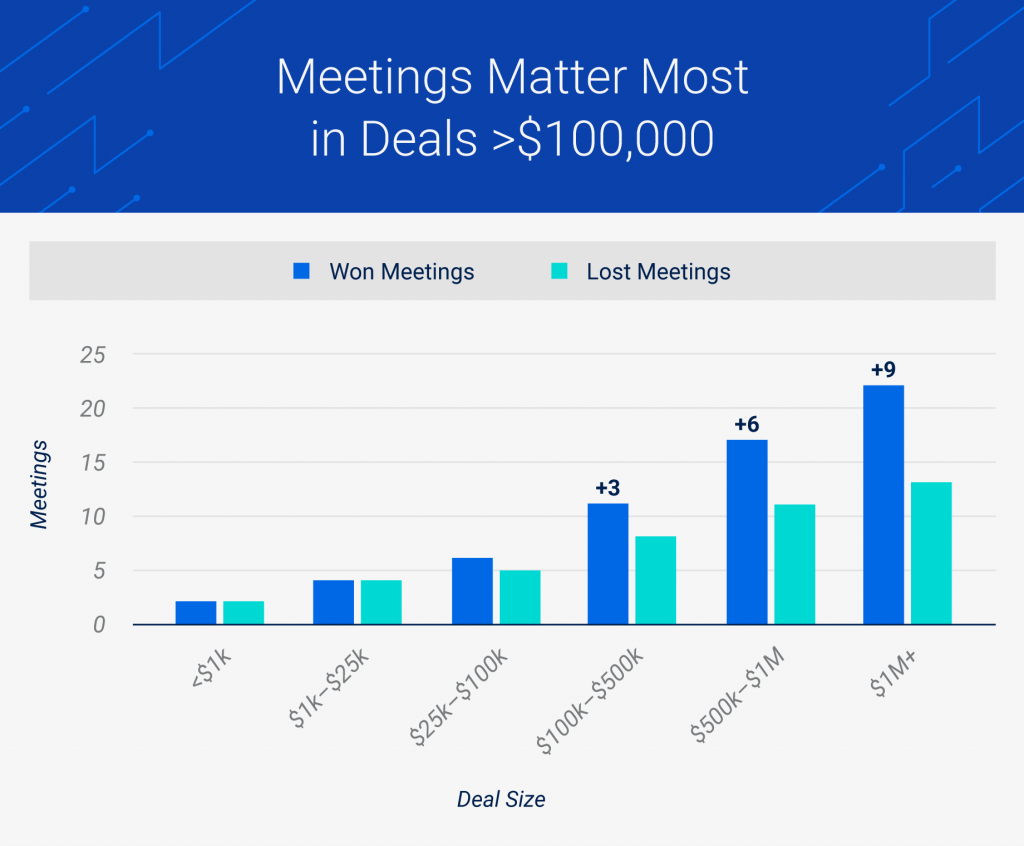Many sales leaders, managers, and reps are guilty of looking at the performance of their deals on a one-off basis, overlooking the forest for the trees. At People.ai, we study the forest to optimize the growth and lifespan of each tree, figuratively speaking.
We analyzed data from 512,740 deals ranging in size from $1,000 to more than $1 million to determine when in the process deals break down and how you can more effectively gauge whether a deal is likely to close or not.
Lost Deals Take Longer to Realize
Deals that are eventually lost drag on 38% longer than those that are won.
It’s obvious that bigger deals have longer sales cycles, but what is less-obvious is that lost deals consistently take about 57 days longer to realize. It’s almost as if there is an expiration date on deals and, depending on your deal size, those between 50 and 220 days should be re-evaluated.
It takes 151 days to win a deal, compared to 208 days to officially lose a deal, on average. This 57-day window should be where you increase your communication with the prospect, either through email or in-person meetings, more on this to come.

Timeline Tips for Winning More Deals
We all know most deals are not won or lost in a single day, but instead the culmination of a lot of work along the way. Even so, there are clearly some pivotal milestones along the lifecycle of any deal.
If your deal sizes are greater than $1,000,000, for example, it’s clear you should start coaching reps to re-engage or re-evaluate opportunities around 170-190 days into the deal. Since these deals typically close around day 220, this should give your reps some time to focus on closing these prospects.
One strategy for utilizing deal expiration dates is to set calendar reminders for yourself to re-evaluate deals one month before the expiration dates outlined in the table below:
Deal SizeCheck-In Reminder (Days)Avg Won Sales Cycle (Days)<$1K1949$1-25K86116$25-100K116146$100-500K146176$500K-1M169199$1M+187217
Won Deals Saw More Email Communication Than Lost Deals
As deal size increases, the amount of email communication intuitively increases, similar to the sales cycle duration, but how much more communication takes place in winning deals, compared to losing deals?
Across the board, deals that were won saw 29% more email communication compared to lost deals. In deals worth $25,000 or more, winning teams sent 45% more emails than losing teams, on average.
The average winning deal saw a total exchange of 141 emails between the account and sales teams.

Tips for Better Email Communication
Of all the sales metrics we measure, communication KPIs are some of the most important. Your team’s sales activity data is telling the story, and if you’re tuned into the right channels to listen, you can learn what leads to more wins.
It's worth noting that while it’s important to stay connected with your accounts and prospects, it's more important not to abuse those relationships and to treat them with the respect they deserve. You're supposed to be a partner to your prospects and customers, not a nuisance.
But, if you do notice a significant decline in emails your reps are sending, this can be a leading indicator of a future decline in sales — which is why you will want to coach them on a few tactics for better email communication:
1. Send meeting agendas
Sending an agenda before a meeting can help showcase your team’s organization and set expectations for the meeting. Be transparent with the agenda — if a pricing discussion is top-of-mind for your team, add it to the agenda. Leaving something as crucial as pricing off the agenda only to spring it on your prospects can come off as a premeditated pressure tactic.
2. Send follow-up emails
Answer any questions your prospects may have had on the call or in the meeting. Some say it takes about 7 interactions with a prospect before they will become a genuine lead, and we can tell you based on our data, reps that won deals at any size sent an average of 52 emails when communicating with prospects. Compare this to the lost deals, where reps sent an average of only 37 emails. Follow up emails can be a great way to stay top-of-mind with prospects after a meeting, demo, or other point of contact.
3. Always include a call-to-action for next steps
ABC — Always. Be. Calling-To-Action. We all know the importance of keeping a prospect warm, but it’s important reps provide themselves the opportunity for a next point of contact. Having a call-to-action in your emails can also make each and every email feel necessary compared to a “just checking in” email.
How Many Meetings Win a Deal?
Face-to-face (or zoom-to-zoom) meetings still matter in deals and they tend to matter more in big deals. In fact, when looking at reasons that deals were lost, reps with deals worth greater than $25,000 conducted five fewer meetings, on average, than those that won the deal.
Five meetings could be the difference between lost and won.
If your deal is worth more than $100,000, you are 53% more likely to win the deal if you have more than 10 meetings. In fact, the average number of meetings to win a deal at every size is 10 meetings. Lost deals conducted only 7 meetings, on average.
Looking closer at the data, as deal size increases at each order of magnitude the number of meetings required to win the deal increases by three. We’re not advocating you study numerology to get more sales, but we are advocating you push for scheduling more meetings in order to increase your chances of winning the deal.

Deals are Lost By Lack of Stakeholder Involvement
We all know how important it is to get buy-in from the decision makers with buying power as well as from your actual end users — but how important is headcount in deals? Turns out, headcount is highly correlated with win rate.
The more people from the prospect’s company you engage in the deal, the more likely you are to win the deal. In fact, each additional person increases the win rate by 4.5%.
Looking at data of more than 250,000 deals that included between 2 and 24 external participants, those with 24 external stakeholders were more than 400% more likely to win the deal, compared to deals with only 2 company contacts.
Stakeholders in the deal are important, but the onus is on the rep to do the work and get the right people at the table as well as understand who their champions and detractors are in any given deal.

How to Win More Deals
We’ve provided ample data in this post to support the fact that people still buy from people, relying on emails, meetings, and stakeholders. It’s not necessarily about involving more people, but involving more of the right people.
It’s important to conduct due diligence during prospecting to make sure you are connecting with the right people but you can also leverage relationship maps to better understand how stakeholders are involved in the deal.
People.ai’s SmartMap, an intelligent relationship map, automatically detects newly engaged contacts in a deal and allows your reps to visually map the deal’s influencers as well as identify individuals that have informal influence over certain departments or decisions.
If you are aware of who your champions are, you can work on turning them into active ambassadors for the deal and if you know who the detractors are, you can dedicate the necessary effort to convince and convert them into champions.
If you are going to increase your win rate you must be able to anticipate deal risk by focusing on time-management of deals, effective communication in emails and meetings, and deploying different strategies for the number of different stakeholders present in your deals. Modern sales leaders are coaching their reps on these factors and more, augmenting their leadership with AI.


![[Data] 5 Characteristics of Closed-Won Deals](https://assets-global.website-files.com/6462847f605fb77f78b2ad89/6462847f605fb77f78b2b412_Where-Most-Deals-are-Lost-header.png)